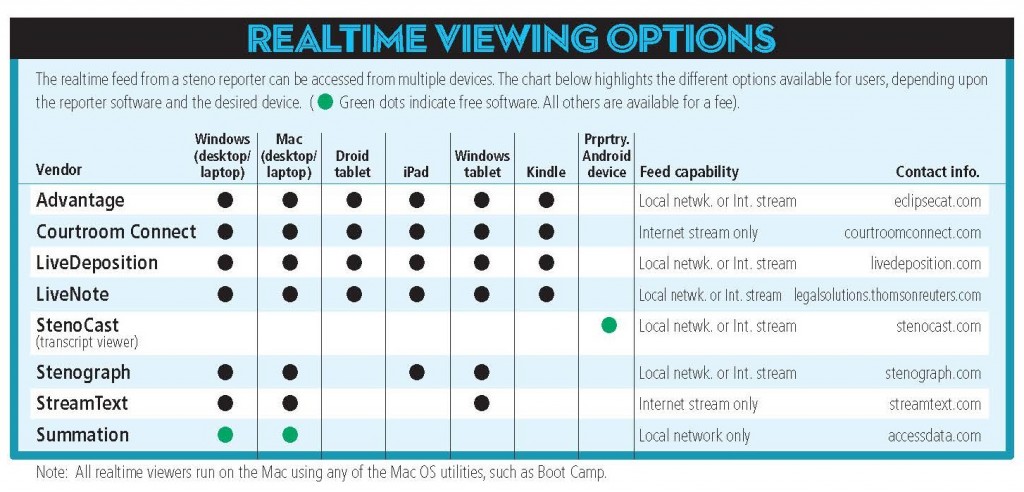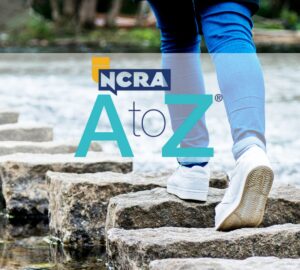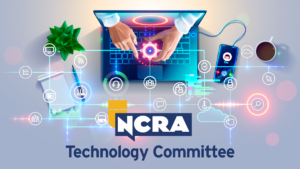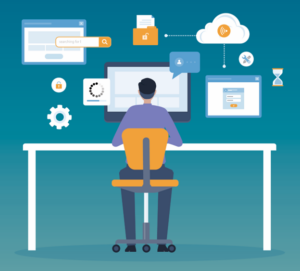By Lisa Knight
With so many different options regarding realtime-viewing software, it’s easy to get lost in the sea of choices! Perhaps you’ve been meaning to keep your CAT software up to date but just haven’t. You’re not making excuses — it’s just the facts. What options do you have for outputting your realtime feed? How will you be able to output your realtime feed to a computer using CaseViewNet? LiveNote? Bridge? TrialBook? Summation? How much will it cost? Can you ditch the cables and go wireless without upgrading your software? Will you be outputting to computers? PCs or Macs? iPads? Kindles? Droids?
In my previous article (TRAIN: Ways to hook up in the January 2014 JCR), we talked about the different hardware you might use to output your realtime feed: cables, Stenocast, and wirelessly through a router. The additional questions you may be asking yourself might include: Which realtime software works best with my current CAT software? Which is the most economical choice for my realtime setup? Where do I start?
First, let’s get a better understanding of some terms that will be used in the article as well as answer some tricky questions that might be a little confusing to understand at first.
WEB BROWSER
A software application for retrieving, presenting, and traversing information resources on the World Wide Web. Examples are: Internet Explorer, Google Chrome, Safari, and Mozilla Firefox.
URL
A uniform resource locator, also known as Web address, particularly when used with HTTP, is a specific haracter string that constitutes a reference to a resource (e.g., http:/www.ncra.org/TRAIN).
ADDRESS BAR
An address bar (also location bar or URL bar) is a feature in a Web browser that shows the current URL and accepts a typed URL that navigates the user to a chosen website. (It’s the physical place where you type in a URL or web address.)
IP [INTERNET PROTOCOL] ADDRESS
A unique string of numbers separated by periods that identifi es each computer using the Internet Protocol to communicate over a network (e.g., 192.161.1.1). This number is a numerical label assigned to each device (e.g., computer, printer, router) participating in a computer network that uses the Internet Protocol for communication. An IP address serves two principal functions: host or network interface identification and location addressing.
For example: Your home or office has an address containing a number, a street name, a city, and a state. Your computer’s IP address is similar to your home address — it tells other computers where your computer “lives.”
Note: Even though IP address has the word Internet in its name, you do not need to have Internet access to be able to use this functionality on computers, phones, or tablets. If your device has a Web browser, then you are able to work with IP addresses by simply typing it (192.168.1.1) into the address bar.
The IP address has many computer functionalities that have nothing to do with the Internet. For example, the IP address is where you program your new router (renaming your router and adding WPA/WPA2 security). By typing in 192.168.1.1 (which is typically the default IP address with all routers), you will have access to your router’s settings and be able to make the necessary changes.
CASEVIEW PROTOCOL
The CAT software outputs information in CaseView “language.”
Think of it this way: If you are speaking Chinese to someone who only speaks French, it will be very difficult (next to impossible) to communicate.
It’s the same with your computer. Your computer “speaks” a specifi c language. If your software is “speaking” (or outputting) realtime CaseView protocol, another computer that doesn’t understand the language of CaseView will not be able to communicate with your realtime feed. The good news here is CaseView protocol is universal to all CAT software (meaning all CAT systems output in the CaseView protocol).
BRIDGE PROTOCOL
The software outputs information in Bridge “language.” (See language explanation in CaseView protocol above.)
INTERNET STREAMING
Our realtime feed is being transmitted over the Internet to anywhere in the world. Internet streaming may also include the transmission of video and audio (Voice over Internet Protocol or VoIP) in conjunction with your realtime feed.
EASY DOES IT
You don’t have to run out and spend $1,000 on a couple of iPads and a router right out of the chute. You probably already have what you need to offer realtime (with your old CAT computer acting as the realtime-viewing computer) at your next deposition or other proceeding.
If you’re like me, you may update your computer system every two to three years. For me, personally, after that period of time, the operating system software (XP, Vista, Windows 7) is outdated and is most likely making my computer programs (specifi cally my CAT software) and ancillary functions run slower, which can make my whole computer system less stable. The last thing I want to have happen in a realtime deposition is the dreaded Blue Screen of Death or my computer system continually hanging.
Having had the good fortune to report way more patent cases than I care to admit, there’s one thing I learned: Manufacturers of computers (and most everything else electronic) have something called planned obsolescence. What does that mean? They want/ need you to update your electronic devices, whether it’s your smartphone, your microwave, or your computer. I think it’s an evil plot on behalf of Corporate America to make me part with my hard-earned money, but at the end of the day, it is my reality if I want to be a successful realtime reporter — not to mention that technology is changing faster than you can boot up an old XP computer!
How many of you still drive the same car you did 10 years ago? How many of you are using the same smartphone you did five years ago? How many of you are wearing the same clothes you wore seven years ago? The thing is, whether you realize it or not, we are constantly updating lots of things in our lives. Sure, a new blouse may be cheaper than a new iPad, but is that new suit cheaper? Maybe not. You wear those (sometimes expensive) business suits because you want to be treated like the skillful and competent court reporter you are. You invest in your professional appearance because you realize it does make a difference in how counsel perceives you. Your computer, your writer, and your software are integral to your professional appearance, so it’s important to stay current.
The last thing you want to do is to be hired to report a (lucrative) realtime job where your realtime feed won’t work properly because your drivers fail to load properly, or a myriad of other issues, because you’re still using the Windows XP operating system. Just “because it always works” may not be a good enough reason to stick with an antiquated system. Dial-up Internet was a deal breaker in its day. How many people still use it? Is it even still around?
Technology and software change at breakneck speed — and although you don’t have to have a Ph.D. in “All Things Computer,” you can be part of the realtime surge that will not only allow you to increase your income but also help secure a future for you and secure the future of the court reporting profession. Although attending a Realtime Systems Administrator class will give you many more details on specific software as well as how to accomplish specific setups, you can also get an amazing amount of realtime information by joining or starting a TRAIN (Taking Realtime Awareness and Innovation Nationwide) group in your area. You can already get a lot of your realtime questions answered and view informative YouTube videos by visiting ncra.org/TRAIN and clicking on Turbo TRAIN: You will find a treasure trove of phenomenal information the TRAIN Committee has compiled just for you!
Although there are many ways to output your realtime feed to computers, tablets, and smartphones, here’s a little more in-depth description of what is currently available in the marketplace. Remember, the realtime landscape is ever changing. The software developers are trying to make our jobs easier all the time! We have many more choices than we did five years ago! When you stay informed, you’re able to make better decisions on when and where to spend your money.
Stenograph has two free realtime-viewing software programs: CaseViewNet (CVN) and iCVNet. CaseViewNet uses the industry standard CaseView protocol, which means if your CAT software can output to CaseView, you can use CaseViewNet. The CaseViewNet software is used with Windows-based computers, netbooks, and Windows Surface Pro tablets. This realtime-viewing software can be used on all CAT systems with output through serial cables, STenocast, and wirelessly through LiveDeposition’s LocalNet.
iCVNet is a free app that is compatible with iPads that requires a wireless (LAN or WAN) connection. However, a CaseViewNet license is required for purchase from Stenograph in order to allow you to send your realtime feed to iCVNet as well as take advantage of the Rapid Refresh functionality.
Go to Stenograph.com and click on the Software tab to download the free CaseViewNet software. To download the free iPad app (iCVNet), visit the App Store on the iPad and search for iCVNet. If you purchase the CaseViewNet license from Stenograph ($295 the fi rst year, $175 for each additional year), you are able to open up the Rapid Refresh functionality of the software so all the changes/corrections you make in your Case CATalyst transcript are instantly made on any CVN or iCVNet feed. No extra buttons to push or commands to execute — the CVN and iCVNet fi le automatically mirrors what is on your screen, word for word.
On a personal note, I use iCVN to iPads with the Rapid Refresh all the time! It makes me look (and feel) like a court reporting rock star when everything on counsel’s screen is squeaky clean and practically perfect — especially in an interpreted deposition when the translator is depending upon my (immaculate) feed for every single question.
Without purchasing the CaseViewNet license from Stenograph, you are still able to use the CaseViewNet realtime-viewing software. The means of connection is only using serial cables, Stenocast, and the LiveDeposition LocalNet router. You cannot connect wirelessly using a traditional router, which you may purchase through your CAT manufacturer, Best Buy, or other electronic store.
At this point, you are probably shaking your head in complete confusion. “Did I read that right? Is that a typo? Did she just say I can connect using a router and then say I cannot connect using a router?” You did read that right, and you do not have to go out and buy another pair of reading glasses! Let me try to explain the difference because there is an important distinction to understand here.
Comparing the traditional router and the LiveDeposition LocalNet router is like comparing apples to oranges. Yes, they are both fruit, but that’s where the comparisons stop. The traditional router and the LiveDeposition LocalNet router are both pieces of hardware that allow you to create LANs and WANs. However, the LiveDeposition LocalNet router has special firmware loaded onto its router that allows you to do things you cannot do with a traditional router.
Think of it like a valet car key and your regular car key. Your regular car key unlocks the doors, the trunk, and the glove compartment, and it starts the engine. The valet car key only unlocks the doors and starts the engine; it does not unlock the trunk or glove compartment. This is so you can safely store items in these areas without fear of them being stolen while having someone else park your car. Sure, they look like identical keys, but you definitely don’t want to be using your valet car key when you need to get into your locked glove compartment to retrieve your iPhone. You can try and try and try. It will never work. It’s the same with these two routers.They look identical, but they are defi nitely not the same!
Note: The CaseViewNet and iCVNet software are free. You can write to CaseViewNet from any modern CAT software using the serial connection mode (serial cables, StenoCast, and LiveDeposition Local Net Router). The CaseViewNet license is available to all Case CATalyst users. You will have the Rapid Refresh functionality once
you purchase this license from Stenograph as well as the ability to use iCVN and iPads.
Stenograph also offers a cloud-streaming product specifically for the Case CATalyst user with their CVN or iCVNet products. Plans and pricing differ.
For best results, those reporters on Case CATalyst who are looking for a free realtime-viewing software that is designed specifically for their software might consider staying with their CAT vendor and using CaseViewNet and iCVN for their realtime-viewing software.
Eclipse has a free realtime-viewing software program named Bridge. This software program uses the Bridge protocol output as well as the CaseView protocol output, so if your software can output to Bridge or CaseView, you can use the Bridge software. Bridge is a software program that is used strictly on Windows-based computers with a connection means of serial cables, Stenocast, or wireless (LAN or WAN). The free Bridge realtime-viewing software has a refresh feature functionality as well (not Rapid Refresh).
Visit eclipsecat.com/content/bridge for a link to download the free Bridge software for your PC.
Eclipse also offers for-pay realtime-viewing software called Bridge Mobile that outputs realtime feed to tablets. It is designed to work on any mobile device. It does this by using Web browser technology.
Remember, that does not mean it requires Internet access. At the time of publication, pricing for Bridge Mobile has yet to be determined. It is anticipated that Bridge Mobile will be available two different ways: an app installed from the App Store and the browser version.
If you want the feed to be broadcast remotely (to off-site participants), you would obviously need to have Internet access, or create a Wide Area Network, in order to access the Eclipse server.
If the realtime feed is only being used in the room you are working in, you do not need to have Internet access. You can create a LAN. The realtime feed does not need to interface with the Eclipse server to accomplish this. The local server sending the realtime feed is the Eclipse Connection Magic program operating on the reporter’s computer. Any device that has an Internet browser (even though not connected to the Internet) can access the realtime feed in this way using an IP address.
For best results, those reporters on Eclipse who are looking for free realtime-viewing software that is designed specifically for their software might consider staying with their CAT vendor and using Bridge for their realtime-viewing software.
StenoCAT offers a for-pay realtime-viewing and Internet streaming software called TrialBook that works specifically with its StenoCAT software. It is browser-based software, like Bridge Mobile. Because it uses a browser, you are able to output your realtime feed to any device that has a browser: iPhone, iPad, Android tablets, Android phones, Windows phones, Windows tablets, PCs, and Mac computers. The cost is $299 per year.
ProCAT offers a for-pay realtime-viewing software called Denoto that works specifically with its ProCAT software. It is browser-based software, like Bridge Mobile. Because it uses a browser, you are able to output your realtime feed to any device that has a browser: iPhone, iPad, Android tablets, Android phones, Windows phones, Windows tablets, PCs, and Mac computers. The cost is $295 per year.
LiveNote (aka Case Notebook) offers its LiveNote realtime-viewing software program. This software program uses both the CaseView protocol output and the Bridge protocol output, so any CAT software that can output to CaseView or Bridge will be able to use the LiveNote realtime software. The LiveNote software is used strictly on computers. An iPad app is in development with expected release sometime in 2014.
LiveNote offers Certified LiveNote Reporter classes and certifications around the country (usually around five classes per year). The cost of the 1.5-day class is $395. The first part is covered by Mark Kislingbury, who shares some of his secrets to speed and clean realtime writing. The second part of the class is learning about the technical aspects of a realtime connection — including how to connect to the LiveNote software through cables, StenoCast wireless, the Internet, and a LAN router wireless connection — with hands-on training and help. LiveNote offers CEUs for its certification class and has a written and hands-on connection test at the conclusion of the course. The pass rate is 95 percent and above.
When you pass the Certified LiveNote Reporter Exam, you are also given five loaner LiveNote licenses, which means five free versions of LiveNote to use on the realtime computers you loan to counsel for their use at the deposition or other setting.
The LiveNote software is a case analysis tool for law firms and is not a free software (unless you take and pass the CLR course/examination). For law firms, the LiveNote software is priced differently, depending on the lawyer and his or her individual needs.
LiveNote realtime-viewing software can be used with all CAT systems with output through serial cables, virtual serial cables (StenoCast), Internet, and wirelessly through a router.
If your CAT output is set to the Bridge protocol, Case Notebook (LiveNote) versions 3 and above will have the auto-refresh functionality in their realtime transcript.
LiveDeposition recently released a new realtime product called LocalNet. The cost is $199 per year. This includes the licensing fee to use its LocalNet software and a wireless router as well as 24/7 technical support and training. It also includes any updates or enhancements the company makes to the product.
Network routers contain built-in programmable logic called firmware. The firmware is embedded software that implements network and security protocols for that specific model of hardware device. LiveDeposition has modified the firmware on its router so it operates differently than an ordinary router you would purchase off the shelf. LiveDeposition’s router is specially designed to work with its particular setup.
Regarding realtime-viewing software, LiveDeposition supports and outputs to them all: CaseViewNet, Bridge, LiveNote, Denoto, TrialBook, Summation, everything.In addition to working on Windows and Mac computers, LiveDeposition has mobile apps for iPhones, iPads, Android smartphones and tablets, as well as the Kindle Fire, so you are able to output your realtime feed to those devices.
LiveDeposition has an app that supports its iPad functionality (go to the App Store and search for LiveDeposition) as well as a Droid app (go to Google Play and search for LiveDeposition). You can also output your realtime to the iPhone by downloading the iPhone app for LiveDeposition. I’m not sure I would ever recommend to a reporter or counsel to receive their realtime feed on the small screen of their smartphone, but it’s always nice to know your options!
When writing to the CaseViewNet protocol output, the LiveDeposition setup allows the Rapid Refresh functionality with a for-pay CVN license from Stenograph. When writing to the Bridge protocol output, the LiveDeposition setup allows the auto-refresh functionality for most realtime-viewing software.
LiveDeposition also has a Web-based streaming product that any reporter can use so long as he or she has the StenoDirectPlus software loaded on his or her computer. Plans and pricing differ. See LiveDeposition.com for more details.

YOU’RE WORTH IT
So where do you want to spend your time and money? How much is your time worth?
Is it more important to get the cables off the tables and write wirelessly without worrying about the headache of setting up counsels’ computers and keeping your fi ngers crossed their computers have administrator rights that allow you (or them) to access their device manager to make the necessary changes so realtime will work?
Will you be able to create the realtime setting without Internet access? Will you have Internet access if the law firm or other setting does not offer it? How much will that cost?
Are you looking for an easier way to output your realtime feed without having to worry about loading drivers or software to counsels’ computers?
Do you want counsel to see all your mistranslates and untranslates, or do you want to make sure you are using a software/hardware combination that will reflect all your changes?
Will the quality of your realtime draft transcript as you are writing be a make-or-break deal for counsel and his or her ability to use, read, or understand your work product during the deposition or other proceedings?
Yes, I do appreciate all this information can be a bit overwhelming (and I know I’ve given you a lot to consider), but you’ve got to start somewhere! And remember, NCRA (through TRAIN and their many other committees) is here to help you! NCRA has YouTube videos that explain the device manager and how to use CaseViewNet or Bridge. There are so many different ways to deliver a quality realtime product to counsel. The choice is all yours!
Lisa Knight, RMR, CRR, is a freelancer in Littleton, Colo., and co-chair of the TRAIN Task Force.
She can be reached at lisa.knight@mac.com. For more information about TRAIN, visit NCRA.org/TRAIN.
See also: TRAIN’s Q&A Session








